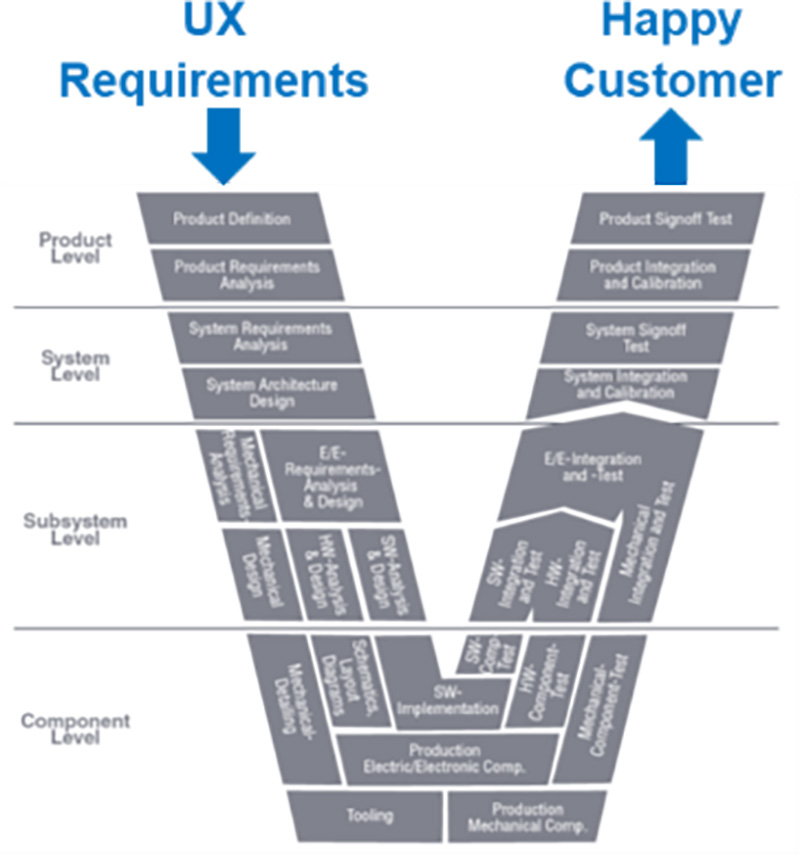Product Development with Systems Engineering
In classical systems engineering thinking, UX is just one category of requirements that are driven through the V model. These requirements need to be specified, designed, developed, integrated, and tested.

(UX requirements in the systems engineering V model (source: NTT DATA))
For the new territory of SDV, we need to add some innovation to this classical approach. The use cases for software-based functions are yet to be discovered. Methods for this discovery include design thinking, customer journeys and in general agile practices for fast feedback loops. As an example, please refer to the playground.digital.auto as a cloud-based, rapid prototyping environment for SDV functions.
More software generates more data. This data can and should be used in early development phases for data-driven engineering, for example the usage patterns of functions or the A/B testing of alternative solutions.
Great User Experience
A great User Experience is shaped by many elements, not isolated touchpoints or point solutions. It’s a concerted efforts by many departments working tirelessly together that all customer expectations are not just met but exceeded. The customer journey mentioned earlier here is a great tool to identify gaps of solutions and services, either not being addressed properly or existent at all.
Strategy, product, engineering and more departments coming together to build out this ecosystem that modern users are used to from day-to-day life with their smartphones, at work, and home. It also is not just the digital layer that influences a great User Experience, both digital and physical worlds need to be harmonized to enable a hyper personalized, curated experience that drives excellence and that works across all aspects of life.
We are looking into the all-Digital Cabin Experience and how this enables a great customer experience inside and outside the vehicle, for example seamless charging, smart home integration, mobile payments, loyalty programs and an overall AI companion.
Systems Engineering meets Customer Experience
Over dinner, we further specified the touchpoints for integrating CX into the product development processes:
1. Customer research and analysis
During the concept generation phase, automotive OEMs conduct thorough market research to understand customer needs, preferences, pain points, and expectations. This information is used to identify unmet needs and develop product concepts that address these concerns.
2. Customer involvement in design
Automotive OEMs are increasingly engaging customers in the design process, inviting them to provide feedback on concept sketches, interior layouts, and feature ideas. This feedback helps to ensure that the vehicle’s design aligns with customer preferences and delivers a compelling user experience.
3. User-centered design (UCD)
UX designers and engineers apply UCD principles to ensure that the vehicle’s controls, interfaces, and overall user experience are intuitive, user-friendly, and enjoyable for drivers and passengers. They conduct usability testing and gather feedback from potential users to refine the design.
4. Omnichannel customer experience
Automotive OEMs are creating seamless customer experiences across all touchpoints, from the initial research phase to post-sales support. This includes providing personalized interactions, intuitive online experiences, and responsive customer service.
5. Data-driven CX
Automotive OEMs are collecting and analyzing customer data to gain insights into their behavior, preferences, and satisfaction levels. This data is used to improve CX strategies, optimize product features, and enhance customer engagement.
6. Immersive experiences
Automotive OEMs are using XR (Augmented / Virtual / Mixed Reality) technologies to provide immersive experiences for customers. This allows them to virtually experience the vehicle’s interior, explore features, and get a sense of its overall design and functionality.
They are also leveraging XR in their design-led product development. CAD can be opened up to multiple functions within the organization, for example Exterior & Interior teams as well as Marketing. The traditional clay model has been more and more replaced by digital tools so that globally distributed teams can collaborate remotely, features and functionalities can be explored and tested faster, and software defined for each regional market. Marketing can leverage the same data for go to market strategies and execution.
7. Feedback loops
Automotive OEMs establish feedback loops throughout the product development process, gathering feedback from customers at various stages, including concept development, prototype testing, and launch. This feedback is used to refine the product and continuously improve CX.

